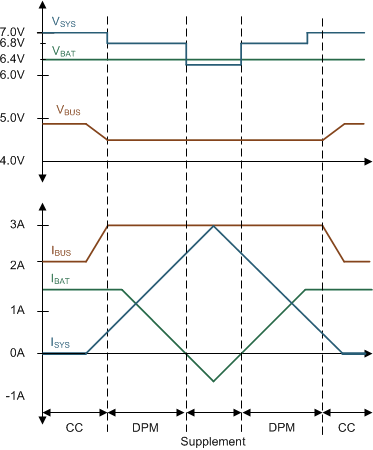JAJSGO0C February 2018 – September 2019 BQ25882
PRODUCTION DATA.
- 1 特長
- 2 アプリケーション
- 3 概要
- 4 改訂履歴
- 5 Device Comparison Table
- 6 Pin Configuration and Functions
- 7 Specifications
-
8 Detailed Description
- 8.1 Overview
- 8.2 Functional Block Diagram
- 8.3
Feature Description
- 8.3.1 Device Power-On-Reset
- 8.3.2 Device Power Up from Battery without Input Source
- 8.3.3 Device Power Up from Input Source
- 8.3.4 Input Current Optimizer (ICO)
- 8.3.5 Buck Mode Operation from Battery (OTG)
- 8.3.6 Power Path Management
- 8.3.7 Battery Charging Management
- 8.3.8 Integrated 16-Bit ADC for Monitoring
- 8.3.9 Status Outputs (PG, and INT)
- 8.3.10 Input Current Limit on ILIM Pin
- 8.3.11 Voltage and Current Monitoring
- 8.3.12 Thermal Regulation and Thermal Shutdown
- 8.3.13 Battery Protection
- 8.3.14 Serial Interface
- 8.4 Device Functional Modes
- 8.5
Register Maps
- 8.5.1 Battery Voltage Regulation Limit Register (Address = 00h) [reset = A0h]
- 8.5.2 Charger Current Limit Register (Address = 01h) [reset = 54h]
- 8.5.3 Input Voltage Limit Register (Address = 02h) [reset = 85h]
- 8.5.4 Input Current Limit Register (Address = 03h) [reset = 39h]
- 8.5.5 Precharge and Termination Current Limit Register (Address = 04h) [reset = 22h]
- 8.5.6 Charger Control 1 Register (Address = 05h) [reset = 9Dh]
- 8.5.7 Charger Control 2 Register (Address = 06h) [reset = 7Dh]
- 8.5.8 Charger Control 3 Register (Address = 07h) [reset = 0Ah]
- 8.5.9 Charger Control 4 Register (Address = 08h) [reset = 0Dh]
- 8.5.10 OTG Control Register (Address = 09h) [reset = F6h]
- 8.5.11 ICO Current Limit Register (Address = 0Ah) [reset = XXh]
- 8.5.12 Charger Status 1 Register (Address = 0Bh) [reset = XXh]
- 8.5.13 Charger Status 2 Register (Address = 0Ch) [reset = XXh]
- 8.5.14 NTC Status Register (Address = 0Dh) [reset = 0Xh]
- 8.5.15 FAULT Status Register (Address = 0Eh) [reset = XXh]
- 8.5.16 Charger Flag 1 Register (Address = 0Fh) [reset = 00h]
- 8.5.17 Charger Flag 2 Register (Address = 10h) [reset = 00h]
- 8.5.18 FAULT Flag Register (Address = 11h) [reset = 00h]
- 8.5.19 Charger Mask 1 Register (Address = 12h) [reset = 00h]
- 8.5.20 Charger Mask 2 Register (Address = 13h) [reset = 00h]
- 8.5.21 FAULT Mask Register (Address = 14h) [reset = 00h]
- 8.5.22 ADC Control Register (Address = 15h) [reset = 30h]
- 8.5.23 ADC Function Disable Register (Address = 16h) [reset = 00h]
- 8.5.24 IBUS ADC 1 Register (Address = 17h) [reset = 00h]
- 8.5.25 IBUS ADC 0 Register (Address = 18h) [reset = 00h]
- 8.5.26 ICHG ADC 1 Register (Address = 19h) [reset = 00h]
- 8.5.27 ICHG ADC 0 Register (Address = 1Ah) [reset = 00h]
- 8.5.28 VBUS ADC 1 Register (Address = 1Bh) [reset = 00h]
- 8.5.29 VBUS ADC 0 Register (Address = 1Ch) [reset = 00h]
- 8.5.30 VBAT ADC 1 Register (Address = 1Dh) [reset = 00h]
- 8.5.31 VBAT ADC 0 Register (Address = 1Eh) [reset = 00h]
- 8.5.32 VSYS ADC 1 Register (Address = 1Fh) [reset = 00h]
- 8.5.33 VSYS ADC 0 Register (Address = 20h) [reset = 00h]
- 8.5.34 TS ADC 1 Register (Address = 21h) [reset = 00h]
- 8.5.35 TS ADC 0 Register (Address = 22h) [reset = 00h]
- 8.5.36 TDIE ADC 1 Register (Address = 23h) [reset = 00h]
- 8.5.37 TDIE ADC 0 Register (Address = 24h) [reset = 00h]
- 8.5.38 Part Information Register (Address = 25h) [reset = 11h]
- 9 Application and Implementation
- 10Power Supply Recommendations
- 11Layout
- 12デバイスおよびドキュメントのサポート
- 13メカニカル、パッケージ、および注文情報
8.3.6.2 Dynamic Power Management
To meet maximum current limit in USB spec and avoid over loading the adapter, the device features Dynamic Power Management (DPM), which continuously monitors the input current and input voltage. When input source is over-loaded, either the current exceeds the input current limit (IINDPM or ICO_ILIM or ILIM pin setting) or the voltage falls below the input voltage limit (VINDPM). The device then reduces the charge current until the input current falls below the input current limit and the input voltage rises above the input voltage limit.
When the charge current is reduced to zero, but the input source is still overloaded, the system voltage starts to drop. Once the system voltage falls below the battery voltage, the device automatically enters the Supplement Mode where the BATFET turns on and battery starts discharging so that the system is supported from both the input source and battery.
During DPM mode, the status register bits VINDPM_STAT (VINDPM) and/or IINDPM_STAT (IINDPM) go high. The figure shows the DPM response with 5-V/3-A adapter, 6.4-V battery, 1.5-A charge current and 6.8-V minimum system voltage setting.
 Figure 20. DPM Response
Figure 20. DPM Response